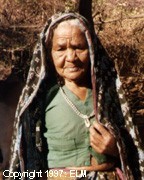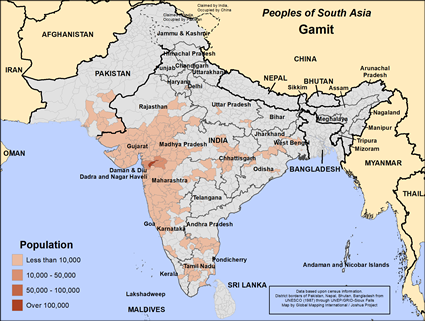The Gamit mainly live in the Surat, Bharuch, Valsad and Dangs districts of Gujarat, India. They are probably a sub tribe of the Bhils. Among the Bhil, the word gamta means headman, possibly giving the Gamit a feeling of superiority over other Bhil tribes. The Gamit are a regimented tribe and consider themselves distinct from the main lineage of Bhil. They are also known as Mavachi. Their language, Gamit, is one of the Bhil languages.
Long ago, the prosperity of Gujarat state enticed people from the surrounding states, thus becoming a target of various Muslim tribes who raided the region annually for many years. The Islamic rulers achieved their greatest power under the Mughal Dynasty and conquered the Gujarat kingdom by the end of the thirteenth century. However, the Hindu Maratha fought the Mughals and also established an empire in Gujarat. While war continued between these and other groups over the Gujarat territory, the British rose to power by 1817. They attempted to mend what the Maratha left behind and dispersed farmland to the settlers.
Gamits believe they belong to the Sun dynasty Rajput community. They might have migrated to India via Khaibar Ghat and Bolanghat of Sindh region and then they might have proceeded to Marwad areas. This is supported by the songs of leel sung by Gamit old ladies during Holi festival. They perform 'Pooja' on any social or religious occasions. The first God to be worshiped is the Sun God. All other Gods are worshiped after this. Another school of thought indicates that the word 'Gamit' came from the word 'Gam' - a village. Those who got settled in a village (a Gam) are Gamits. Those who are settled are also known as Vasava.
Gamits are settled in villages. Their houses are not in a row of strait line like city chawls. Though they stay in vicinity of each other, they are independently situated. All houses have open spaces around four walls. Sometimes the houses are built on small hills; and some houses are built in the foot-step of hills.
The building material is clay, cow dung, and paddy grass. Bamboos are used in the construction of walls. The roofs are constructed suitable to geographical conditions. Either indigenous or Manglory tiles are used to cover roofs. In modern times, some houses now have RCC roofs.
Gamits stay in houses owned by them. In their houses, they keep the utensils made from copper, brass, aluminum, steel, clay or glass. Besides, they have some mattresses, cots, kerosene lamps, a wooden stand, a drum to store food-grain, a radio, T.V., Tape recorder, tin box and steel cupboard etc.
They are usually a steady agricultural community. Some people whose land has been snatched away, work as agricultural laborers or other laborers because they are deprived of their ancestor's land. Besides some people prefer to go for employment, thanks to the level of education which is going up day by day. Some go for animal husbandry and others work in nearby factories.
In Gamit community, there is formal or informal caste - panch for controls and regulations in their social dealings. The people from the Gamit community meet to-gather and constitute the caste-panch for community members to follow rules and regulations. Besides, Gamits have their written constitution. The caste-Panch looks after the cases of marriages, re-marriages, divorce, education etc.
Although other Bhil tribes (the Dubla, the Chaudhari and the Dhodia) live in the same region as the Gamit, they live in separate villages. The marriages among Gamit are mostly in the same gotra (caste). The objective is to find a spouse from a known family. The men take more than one wife when they can afford it. They "buy" the wives while they are still young girls. At wedding parties, the men sing rather than the women.
A Gamit marriage is performed both traditionally as well as according to Hindu customs with a Brahmin getting it performed. Dinner follows marriage. This community believes in customs like Aana, Khandhad marriage, love marriage, to marry a sister of a wife if wife expires (salivatu) or to marry a younger brother of husband, if the husband expires (Diyarvatu), Polygamy, re-marriage after divorce etc.
If a young couple wishes to marry but cannot afford the bride price, it is common for the young man to willingly abduct the girl. They return home after several months and receive approval for their union.
The Gamit and the Chaudhari are culturally very similar, but the traditions of the Gamit are much stronger. It is even said that they have one more rib than the others. The Gamit, unlike the Chaudhari, do not have theatrical dramas at their festivals. Instead, community singing provides variety to their festivals. While the Dhodia women wear necklaces made of beads and coins, the Gamit women adorn themselves with necklaces made of rows of shells.
Gamits believe in Hindu gods and goddesses. They also have faith in their traditional tribal gods/goddesses like Devli Madi, Gaumukh, Dunger Dev, Gowal Dev, Anaj Dev etc. They keep vows and also go on Hindu pilgrimages.
They celebrate several festivals like Gam dev no, Holi, Gowal Dev festival, Vaghdev Mahadev, Dussera, Diwali, Nano Dev-Moto Dev, etc.
Many Gamit struggle with alcohol addiction. This traps their families and communities in hardship.
Pray that the Lord of the harvest will send forth quality laborers to live among the Gamit and show them Christ's love.
Pray for the effectiveness of the JESUS Film among the Gamit and other Bhil peoples.
Pray for the Holy Spirit to give Gamit people a spiritual hunger that will lead them to the cross.
Scripture Prayers for the Gamit in India.
https://joshuaproject.net/people_groups/16781/PK
https://en.wikipedia.org/wiki/Gamit
https://en.wal.unesco.org/countries/india/languages/gamit
https://trti.gujarat.gov.in/gamit
| Profile Source: Joshua Project |











